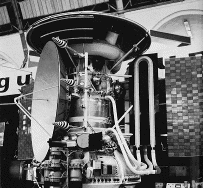|
|
Mars 4 & 5

Mars 4 was launched by the USSR on 21 July 1973 and its twin, Mars 5, was
launched 4 days later on 25 July. As Mars 4 approached the red planet on 10
February 1974, its retro-engine malfunctioned. Alas, rather than going into
orbit around the planet, it went into a heliocentric orbit. However, in
February 1974, the Mars 5 probe was put successfully into orbit around Mars,
with apoapsis 32,560 km, periapsis 1760 km. The inclination of the orbit to
the equator of the planet was 35 degrees. It took 24 hours 53 minutes to
complete one orbit. Both probes contained identical sets of instruments
intended to investigate the composition, structure, and properties of the
Martian atmosphere and surface.
Mars 4 & 5 both contained a 256-channel NaI scintillation gamma-ray
spectrometer
which was 63x63 mm, with charged particle rejection. It covered the energy
range 1-9 MeV. The instrument was located on a boom away from the
spacecraft body. Its primary objective was to measure the spectral
composition of Mars' gamma-radiation. However, a series of measurements of
the cosmic gamma-ray background were made during the flight from Earth to
Mars. Six measurements sessions were performed at 61.2, 85.4, and 93.8
million miles from Earth.
The Mars 4 & 5 gamma-ray spectrometers found an average cosmic
gamma-radiation
background flux density of 1.85e4 quanta/sq-m/s. Mars 5 went on to be a great
success in its primary studies of Mars.
- Johnson 1979, Handbook of Soviet Lunar and Planetary Exploration,
pp. 198-203.
- Surkov, Exploration of Terrestrial Planets from Spacecraft, pp. 184-212.
[Gallery]
[All Missions]
[by Time]
[by Energy]
Page authors: Lorella Angelini Jesse Allen
HEASARC Home |
Observatories |
Archive |
Calibration |
Software |
Tools |
Students/Teachers/Public
Last modified: Thursday, 26-Jun-2003 13:48:18 EDT
|


